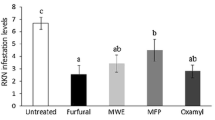Abstract
Pot and greenhouse trials were conducted for the management of root-knot nematode, Meloidogyne javanica, infestation in tomato. Growth parameters, gall index, soil, and root nematode populations were measured to assess the effect of a novel bio-pesticide (Dazitol®), made from mustard oil and oleoresin of Capsicum, on plant growth and nematode reproduction. Data generated within the pot experiment showed that the tested bio-pesticide did not improve plant growth, but it reduced significantly root-knot nematode damage resulting in a decrease in gall index and root (91%) and soil (62%) population of M. javanica compared with untreated plants. The greenhouse experiment showed that Mocap® and Dazitol® decreased nematode incidence significantly (P < 0.05) on tomato. The result of this study suggested that the best nematode control was obtained by combining soil solarization with chemical or botanical nematicides as an integrated pest management approach.

Similar content being viewed by others
References
Abd-Elgawad MM (2008) The current status of phytonematode management in Egypt with special reference to applicable nematicides. Egypt J Agron 6:33–46
Caboni P, Ntalli NG (2014) Botanical nematicides, recent findings. In: Gross AD, Coats JR, Duke SO, Seiber JN (eds) Biopesticides: state of the art and future opportunities. American Chemical Society, Washington DC, pp 145–157
Coolen WA (1979) Methods for the extraction of Meloidogyne spp. & other nematodes from roots and soil. In: Lamberti F, Taylor CE (eds) Root-knot nematodes (Meloidogyne Species) systematics, biology and control. Academic Press, London, pp 317–329
De Grisse AT (1969) Redescription ou modification de quelques techniques utilisée dans l’étude des nématodes phytoparasitaires. Mededelingen Rijksfaculteit der Landbouwetinschap, Gent, pp 351–369
Elhajji L, Horrigue-Raouani N (2012) Efficiency of solarization and incorporation of cattle manure in management of Meloidogyne javanica (Treub.) Chitwood and Globodera pallida (stone) Behrens associated with potato. Pest Technol 6:75–78
Fleming CC, Turner SJ, Hunt M (2006) Management of root knot nematodes in turfgrass using mustard formulations and biostimulants. Commun Agric Appl Biol Sci 71(3):653–658
Gamliel A, Stapleton JJ (1993) Characterization of antifungal volatile compounds evolved from solarized soil amended with cabbage residues. Phytopathology 83:899–905
Horrigue-Raouani N (2003) Variabilité de la relation hôte parasite dans le cas des Meloidogyne spp. (Nematoda: Meloidogynidae). Thèse de docteur d’état. Université Tunis-El Manar, Faculté des Sciences de Tunis, Tunis, pp 222
Hussey RS, Barker KR (1973) A comparison of methods of collecting inocula of Meloidogyne spp. including a new technique. Plant Dis Rep 57:1025–1028
Hussey RS, Janssen GJW (2002) Root-knot nematode: Meloidogyne species. In: Starr JL, Cook R, Bridge J (eds) Plant resistance to parasitic nematodes. CAB International, Wallingford, pp 43–70
Katan J, Greenberger A, Alon H, Grinstein A (1976) Solar heating by polyethylene mulching for the control of diseases caused by soilborne pathogens. Phytopathology 66:683–688
Martin TJ, Turner SJ, Fleming CC (2007) Management of the potato cyst nematode (Globodera pallida) with bio-fumigants/stimulants. Commun Agric Appl Biol Sci 72(3):671–675
Mekete T, Decraemer W, Wesemael WML, Seid A, Fininsa C (2015) Tomato (Solanum lycopersicum) and root-knot nematodes (Meloidogyne spp.)—a century-old battle. Nematology 17:1–15
Moens M, Perry RN, Starr JL (2009) Meloidogyne species—a diverse group of novel and important plant parasites. In: Perry RN, Moens M, Starr JL (eds) Root knot nematodes. CAB International, Wallingford, p 483
Oka Y, Nurit S, Pinchas F (2007) Control of root-knot nematodes in organic farming systems by organic amendments and soil solarization. Crop Prot 26(10):1556–1565
Pharand B, Carisse O, Benhamou N (2002) Cytological aspects of compost-mediated induced resistance against Fusarium crown and root rot in tomato. Phytopathology 92:424–438
Ploeg A (2008) Biofumigation to manage plant-parasitic nematodes. In: Ciancio A, Mukherjee KG (eds) Integrated management and biocontrol of vegetable and grain crop nematodes. Springer, Dordrecht, pp 239–248
Reddy PP (2011) Biofumigation and solarization for management of soil borne plant pathogens, vol 431. Scientific publishers, Jodhpur
Salem MF (2014) Innovative approaches through modified biofumigation in controlling soil-borne pathogens and root-knot nematode. Aspects of Applied Biology 126, 5th International Symposium of Biofumigation, UK
Seid A, Fininsa C, Mekete T, Decraemer W, Wesemael W (2015) Tomato (Solanum lycopersicum) and root-knot nematodes (Meloidogyne spp.): a century-old battle. Nematology 17(9):995–1009
Sikora RA, Fernandez E (2005) Nematode parasites of vegetables. In: Luc M, Sikora RA, Bridge J (eds) Plant parasitic nematodes in subtropical and tropical agriculture. CAB International, Wallingford, pp 319–392
Stapleton JJ, Heald CM (1991) Management of phytoparasitic nematodes by soil solarization. In: Katan J, JE DV (eds) Soil solarization. CRC Press, Boca Raton, pp 51–59
Stoddard FL, Nicholas AH, Rubiales D, Thomas J, Villegas-Fernández AM (2010) Integrated pest management in faba bean. Field Crop Res 115(3):308–318
Talavera M, Sayadi S, Chirosa-Ríos M, Salmerón T, Flor-Peregrín E, Verdejo-Lucas S (2012) Perception of the impact of root-knot nematode-induced diseases in horticultural protected crops of South-Eastern Spain. Nematology 14:517–527
Thoden TC, Korthals GW, Termorshuizen AJ (2011) Organic amendments and their influence on plant parasitic and free living nematodes: a promising method for nematode management. Nematology 13:133–153
Author information
Authors and Affiliations
Corresponding author
Ethics declarations
This study does not involve any human and/or animal participant.
Conflict of interest
The authors declare that they have no conflict of interest.
Additional information
Responsible editor: Philippe Garrigues
Rights and permissions
About this article
Cite this article
Hajji-Hedfi, L., Rebai, E., Larayedh, A. et al. Biological control of Meloidogyne javanica on tomato with Dazitol® and soil solarization. Environ Sci Pollut Res 25, 17278–17282 (2018). https://doi.org/10.1007/s11356-018-1962-x
Received:
Accepted:
Published:
Issue Date:
DOI: https://doi.org/10.1007/s11356-018-1962-x




